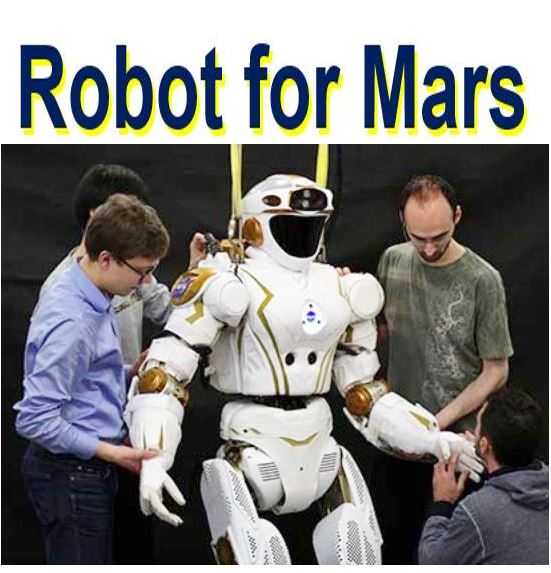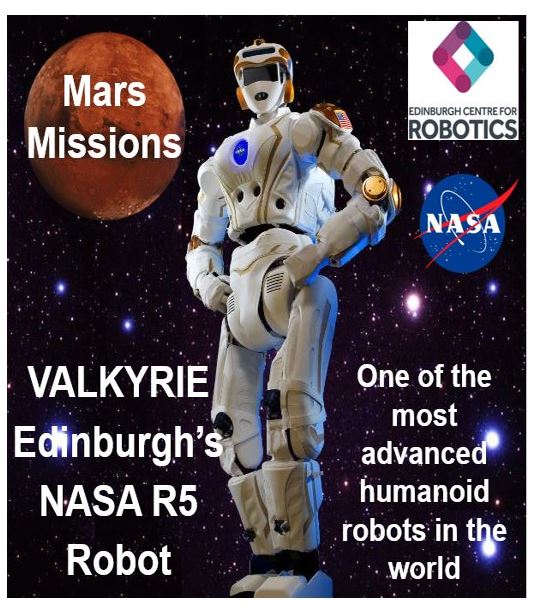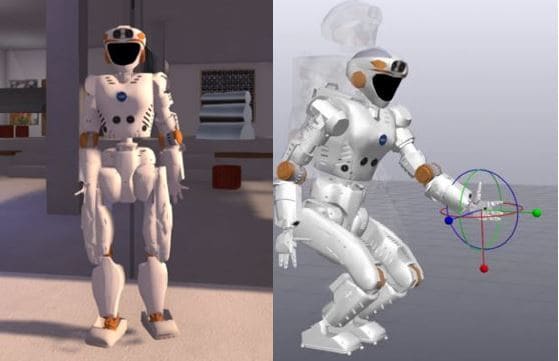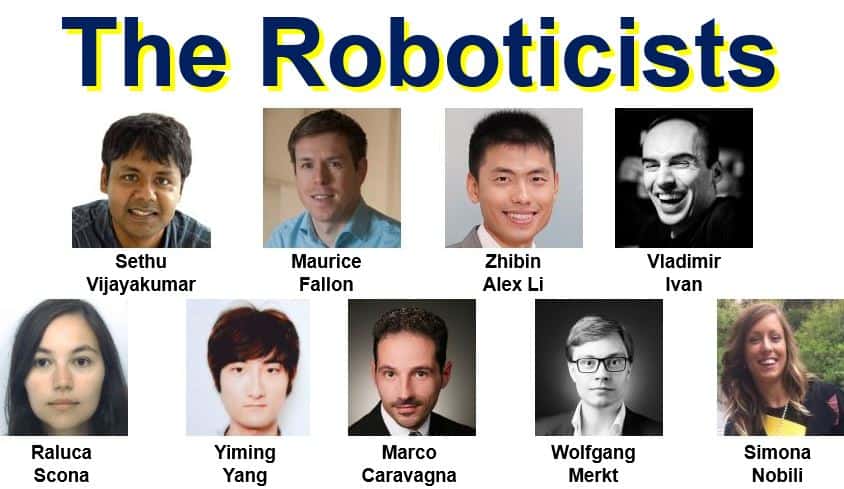A team of Scottish scientists has created a robot that looks like a human, intended for future NASA Mars missions. The humanoid machine – called Valkyrie – weighs 19.7 stones (275 lbs or 125 kg) and is 6ft 11ins (1.8 metres) tall.
Its name comes from Norse mythology – Valkyrie was a female figure who chose which fighters died in battle and which ones survived. It is the result of a collaboration between a team of scientists in Edinburgh and the US space agency NASA.
The robot scientists’ task is to improve Valkyrie’s physical and computational abilities. The humanoid machine is currently able to walk upright and perform fairly basic movements, including holding and manipulating objects.
 NASA wants to send Valkyrie – the humanoid robot – to Mars first, to prepare things for human astronauts who would follow a few years later. In this image you can see the robot with some PhD students. (Image: hw.ac.uk/img)
NASA wants to send Valkyrie – the humanoid robot – to Mars first, to prepare things for human astronauts who would follow a few years later. In this image you can see the robot with some PhD students. (Image: hw.ac.uk/img)
Valkyrie needs to be upgraded
For Valkyrie to be effective and useful as part of a Mars mission, which will include humans and robots, it will need a much more sophisticated set of skills – it needs to better understand and respond to its surroundings.
What is a robot?
Chair of Robotics at the School of Informatics and Director of the Edinburgh Centre for Robotics, Professor Sethu Vijayakumar, and fellow scientists will attempt to improve the robot’s ability to handle things and walk – it must become more nimble with both its hands and feet.
They will work on the robot’s sophisticated on-board sensors so that it can make better sense of its surroundings and achieve better manoeuvrability.
 Dr. Maurice Fallon, from the Unviversity of Edinburgh, said: “Our team is excited to start adapting their research to work with the robot – especially after our training visit to NASA’s Johnson Space Center in January. It will be a big challenge but also an excellent way to learn about state-of-the-art robotics.” (Image: valkyrie.inf.ed.ac.uk)
Dr. Maurice Fallon, from the Unviversity of Edinburgh, said: “Our team is excited to start adapting their research to work with the robot – especially after our training visit to NASA’s Johnson Space Center in January. It will be a big challenge but also an excellent way to learn about state-of-the-art robotics.” (Image: valkyrie.inf.ed.ac.uk)
The roboticists will also attempt to improve Valkyrie’s ability to interact safely and closely with human beings and other machines.
A unique robot
Prof. Vijayakumar says this robot is the only one of its type in the whole of Europe, and just one of three prototypes that exist worldwide.
NASA wants to send a robot to Mars many years before human astronauts set foot on the Red Planet and try to set up a permanent colony there. The robot would be sent to Mars first to undertake pre-deployment tasks, as well as being in charge of maintaining assets.
The researchers said Valkyrie was designed to be humanoid – look like a human – so that could be part of a human-and-machine team, working alongside people. It will also perform tasks that humans will not do because they are too dangerous.
 The NASA R5 robot is a new humanoid machine initially created to complete disaster-relief operations. However, its main goal is to prove itself worthy of deep space exploration, specifically Mars missions. (Image: valkyrie.inf.ed.ac.uk)
The NASA R5 robot is a new humanoid machine initially created to complete disaster-relief operations. However, its main goal is to prove itself worthy of deep space exploration, specifically Mars missions. (Image: valkyrie.inf.ed.ac.uk)
Valkyrie is being developed at the Edinburgh Centre for Robotics, a joint initiative between the University of Edinburgh and Heriot-Watt University.
Regarding the challenge the team faces, Prof. Vijayakumar said:
“Valkyrie is a huge scientific undertaking. We are looking forward to tackling the many technical challenges involved in developing a large-scale humanoid robot, and pushing the state of the art in humanoid robotics.”
 Valkyrie was constructed by NASA’s Johnson Space Center in 2015 and delivered to the University of Edinburgh in Spring 2016. (Image: valkyrie.inf.ed.ac.uk)
Valkyrie was constructed by NASA’s Johnson Space Center in 2015 and delivered to the University of Edinburgh in Spring 2016. (Image: valkyrie.inf.ed.ac.uk)
Professor David Lane, from Heriot-Watt’s School of Engineering & Physical Sciences Sensors, Signals & Systems, said:
“This is a fascinating project, a huge scientific challenge for the Centre in conjunction with NASA.”
In 2013, Valkyrie robotic platform was initially designed and built to carry out search and rescue missions. After a series of electro-mechanical improvements and a software partnership with IHMCC, the platform is now a core robotic platform in the NASA Space Robotics Challenge.
 The team currently working with the robot consists of research staff and students from the Robot Perception Group and the Statistical Machine Learning and Motor Control Group. (Image: valkyrie.inf.ed.ac.uk)
The team currently working with the robot consists of research staff and students from the Robot Perception Group and the Statistical Machine Learning and Motor Control Group. (Image: valkyrie.inf.ed.ac.uk)
What is robotics?
“Robotics is the study of robots. Robots are machines that can be used to do jobs. Some robots can do work by themselves. Other robots must always have a person telling them what to do.”
“NASA uses robots in many different ways. Robotic arms on spacecraft can move large objects in space. Robotic spacecraft can visit other worlds. Robotic airplanes can fly without a pilot aboard. NASA is studying new types of robots. These will work with people and help them.”
Robots are used to help us explore space. The unmanned spacecraft we send to explore other worlds, such as the Moon or Mars, are robots. These include landers, orbiters, and rovers on other planets.
The Mars rovers Opportunity and Spirit are both robots. Other robotic spacecraft orbit or fly by other worlds. They study planets from space.
The Valkyrie project is being funded by the Engineering and Physical Sciences Research Council (EPSRC).
A team from @EDINrobotics are working with @NASA on a humanoid robot that they hope to send to Mars.. #Valkyriehttps://t.co/zd9hcVAsyF
— BBC Breakfast (@BBCBreakfast) 5 May 2016
